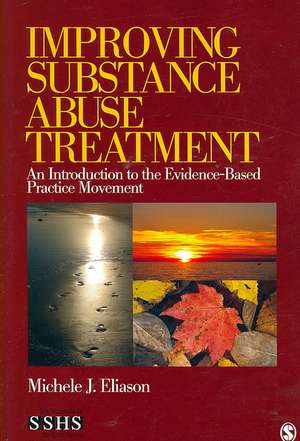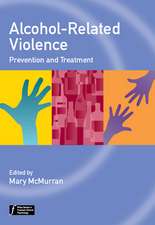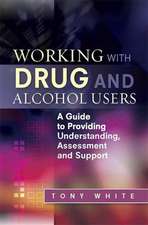Improving Substance Abuse Treatment: An Introduction to the Evidence-Based Practice Movement: SAGE Sourcebooks for the Human Services
Autor Michele J. Eliasonen Limba Engleză Paperback – 9 iul 2007
| Toate formatele și edițiile | Preț | Express |
|---|---|---|
| Paperback (1) | 437.63 lei 43-57 zile | |
| SAGE Publications – 9 iul 2007 | 437.63 lei 43-57 zile | |
| Hardback (1) | 720.21 lei 43-57 zile | |
| SAGE Publications – 9 iul 2007 | 720.21 lei 43-57 zile |
Din seria SAGE Sourcebooks for the Human Services
- 15%
 Preț: 552.84 lei
Preț: 552.84 lei - 18%
 Preț: 716.25 lei
Preț: 716.25 lei - 18%
 Preț: 837.47 lei
Preț: 837.47 lei - 27%
 Preț: 1085.35 lei
Preț: 1085.35 lei - 18%
 Preț: 1088.77 lei
Preț: 1088.77 lei - 18%
 Preț: 920.90 lei
Preț: 920.90 lei - 9%
 Preț: 886.73 lei
Preț: 886.73 lei - 18%
 Preț: 717.85 lei
Preț: 717.85 lei - 18%
 Preț: 721.16 lei
Preț: 721.16 lei - 15%
 Preț: 553.81 lei
Preț: 553.81 lei - 18%
 Preț: 787.97 lei
Preț: 787.97 lei - 18%
 Preț: 786.59 lei
Preț: 786.59 lei - 18%
 Preț: 923.40 lei
Preț: 923.40 lei - 15%
 Preț: 611.89 lei
Preț: 611.89 lei - 18%
 Preț: 921.69 lei
Preț: 921.69 lei - 18%
 Preț: 918.05 lei
Preț: 918.05 lei - 18%
 Preț: 790.02 lei
Preț: 790.02 lei - 18%
 Preț: 790.51 lei
Preț: 790.51 lei - 27%
 Preț: 831.95 lei
Preț: 831.95 lei - 15%
 Preț: 608.64 lei
Preț: 608.64 lei - 18%
 Preț: 838.73 lei
Preț: 838.73 lei - 18%
 Preț: 922.47 lei
Preț: 922.47 lei - 18%
 Preț: 1209.42 lei
Preț: 1209.42 lei - 18%
 Preț: 918.20 lei
Preț: 918.20 lei - 5%
 Preț: 546.82 lei
Preț: 546.82 lei - 18%
 Preț: 926.56 lei
Preț: 926.56 lei - 18%
 Preț: 786.41 lei
Preț: 786.41 lei - 15%
 Preț: 405.98 lei
Preț: 405.98 lei
Preț: 437.63 lei
Preț vechi: 514.86 lei
-15% Nou
Puncte Express: 656
Preț estimativ în valută:
83.74€ • 87.65$ • 69.70£
83.74€ • 87.65$ • 69.70£
Carte tipărită la comandă
Livrare economică 31 martie-14 aprilie
Preluare comenzi: 021 569.72.76
Specificații
ISBN-13: 9781412951319
ISBN-10: 1412951313
Pagini: 200
Dimensiuni: 152 x 229 x 11 mm
Greutate: 0.27 kg
Ediția:1
Editura: SAGE Publications
Colecția Sage Publications, Inc
Seria SAGE Sourcebooks for the Human Services
Locul publicării:Thousand Oaks, United States
ISBN-10: 1412951313
Pagini: 200
Dimensiuni: 152 x 229 x 11 mm
Greutate: 0.27 kg
Ediția:1
Editura: SAGE Publications
Colecția Sage Publications, Inc
Seria SAGE Sourcebooks for the Human Services
Locul publicării:Thousand Oaks, United States
Cuprins
Acknowledgments
Ch 1: Introduction
Challenges
A Working Definition of Evidence-Based Practice
Overview of the Book
Ch 2: What Are Evidence-Based Practices?
Bias in Research Studies
What Is Treatment as Usual?
Research-Practice Gaps
Bridging the Gap
Types of Research-Based Practices
Clinical Practice Guidelines/Consensus Documents
Evidence-Based Practices
Practice Improvements
Some Challenges to the Evidence-Based Practice Movement
Conclusions
Ch 3: Determining What Is Evidence-Based
What Is "Evidence"?
Three Efforts to Develop Criteria for Evidence-Based Practice
The Iowa Experience
The Oregon Mandate
The Federal Response: National Registry of Effective Practices and Programs (NREPP)
Conclusions
Addendum: Suggestions for Developing Criteria
Ch 4: Adoption and Implementation of Evidence-Based Practices
Assessment of Readiness to Change
Instituting Organizational Change
Challenges to Implementation
Training Issues
Client Variation
Provider/Staff Variation
Program/Agency Variation
Buy-In
Commitment
Negative Attitudes/Lack of Knowledge About Research
Lack of Practice-Research Partnerships/Collaborations
Lack of Resources
Organizational Structure
The Practice Itself
Stigma
Conclusions
Ch 5: Evaluation of Evidence-Based Practices
Process Evaluation (Fidelity)
Outcome Evaluation
Program Evaluation
Conclusions
Ch 6: A Research Primer: Overview, Hypotheses, and Variables
Why Is Research Important?
Types of Research
Quantitative and Qualitative
Laboratory and Field Studies
The Research Process (Step by Step)
Research Questions/Hypotheses
Variables
Conclusions
Ch 7: Research Methods
Two Basic Types of Research Designs
The Gold Standard: Randomized Clinical Trials
Other Research Designs
Selecting a Sample
Generalizability of Samples
Institutional Review Boards
Loss of Confidentiality
Risk-Benefit Analyses
Misrepresentation of Risks or Benefits
Coercion
Safeguards
Research Procedures/Data Collection
Cross-Sectional Versus Longitudinal Designs
Data Collection Methods
Conclusions
Ch 8: Data Analysis and Interpretation
Descriptive Statistics
Reliability and Validity of Measurement Tools
Interpreting Descriptive Statistics
Inferential Statistics
Other Statistical Methods
Methods for Understanding Inferential Statistics
Example: Interpretation of a Clinical Trial
Sample
Method
Outcome Measures
Results
Interpretation/Application
Conclusions
Ch 9: Qualitative Research, Dissemination, and Funding
Introduction to Qualitative Research
Qualitative Methods
Another Example of Qualitative Research in Substance Abuse
Data Reporting and Dissemination
Funding Sources
Conclusions
Ch 10: Conclusions and Future Directions
Barriers to Conducting Research in Substance Abuse Treatment and Prevention Agencies
Major Themes Identified in This Book
Implications for the Field
Recommendations
Conclusions
Glossary of Key Terms
References and Web Resources
Appendix A: Text of Oregon Law
Index
About the Author
Ch 1: Introduction
Challenges
A Working Definition of Evidence-Based Practice
Overview of the Book
Ch 2: What Are Evidence-Based Practices?
Bias in Research Studies
What Is Treatment as Usual?
Research-Practice Gaps
Bridging the Gap
Types of Research-Based Practices
Clinical Practice Guidelines/Consensus Documents
Evidence-Based Practices
Practice Improvements
Some Challenges to the Evidence-Based Practice Movement
Conclusions
Ch 3: Determining What Is Evidence-Based
What Is "Evidence"?
Three Efforts to Develop Criteria for Evidence-Based Practice
The Iowa Experience
The Oregon Mandate
The Federal Response: National Registry of Effective Practices and Programs (NREPP)
Conclusions
Addendum: Suggestions for Developing Criteria
Ch 4: Adoption and Implementation of Evidence-Based Practices
Assessment of Readiness to Change
Instituting Organizational Change
Challenges to Implementation
Training Issues
Client Variation
Provider/Staff Variation
Program/Agency Variation
Buy-In
Commitment
Negative Attitudes/Lack of Knowledge About Research
Lack of Practice-Research Partnerships/Collaborations
Lack of Resources
Organizational Structure
The Practice Itself
Stigma
Conclusions
Ch 5: Evaluation of Evidence-Based Practices
Process Evaluation (Fidelity)
Outcome Evaluation
Program Evaluation
Conclusions
Ch 6: A Research Primer: Overview, Hypotheses, and Variables
Why Is Research Important?
Types of Research
Quantitative and Qualitative
Laboratory and Field Studies
The Research Process (Step by Step)
Research Questions/Hypotheses
Variables
Conclusions
Ch 7: Research Methods
Two Basic Types of Research Designs
The Gold Standard: Randomized Clinical Trials
Other Research Designs
Selecting a Sample
Generalizability of Samples
Institutional Review Boards
Loss of Confidentiality
Risk-Benefit Analyses
Misrepresentation of Risks or Benefits
Coercion
Safeguards
Research Procedures/Data Collection
Cross-Sectional Versus Longitudinal Designs
Data Collection Methods
Conclusions
Ch 8: Data Analysis and Interpretation
Descriptive Statistics
Reliability and Validity of Measurement Tools
Interpreting Descriptive Statistics
Inferential Statistics
Other Statistical Methods
Methods for Understanding Inferential Statistics
Example: Interpretation of a Clinical Trial
Sample
Method
Outcome Measures
Results
Interpretation/Application
Conclusions
Ch 9: Qualitative Research, Dissemination, and Funding
Introduction to Qualitative Research
Qualitative Methods
Another Example of Qualitative Research in Substance Abuse
Data Reporting and Dissemination
Funding Sources
Conclusions
Ch 10: Conclusions and Future Directions
Barriers to Conducting Research in Substance Abuse Treatment and Prevention Agencies
Major Themes Identified in This Book
Implications for the Field
Recommendations
Conclusions
Glossary of Key Terms
References and Web Resources
Appendix A: Text of Oregon Law
Index
About the Author
Notă biografică
Michele (Mickey) Eliason, PhD, is an adjunct professor at the Institute for Health and Aging at the University of California, San Francisco. She also teaches courses about sexuality and gender at San Francisco State University. Formerly, she was a faculty member in the College of Nursing at the University of Iowa for nearly 20 years. Dr. Eliason has been an applied researcher in the substance abuse treatment field for over 15 years, and is particularly interested in diverse populations including women and sexual/gender minority clients. Her interest in the evidence-based practice movement came out of a four year involvement with the Iowa Practice Improvement Collaborative, funded by CSAT to develop a statewide practice-research collaboration. This highly rewarding experience highlighted the complex barriers to implementing evidence-based practices in the poorly funded and stigmatized settings of community based treatment programs.








